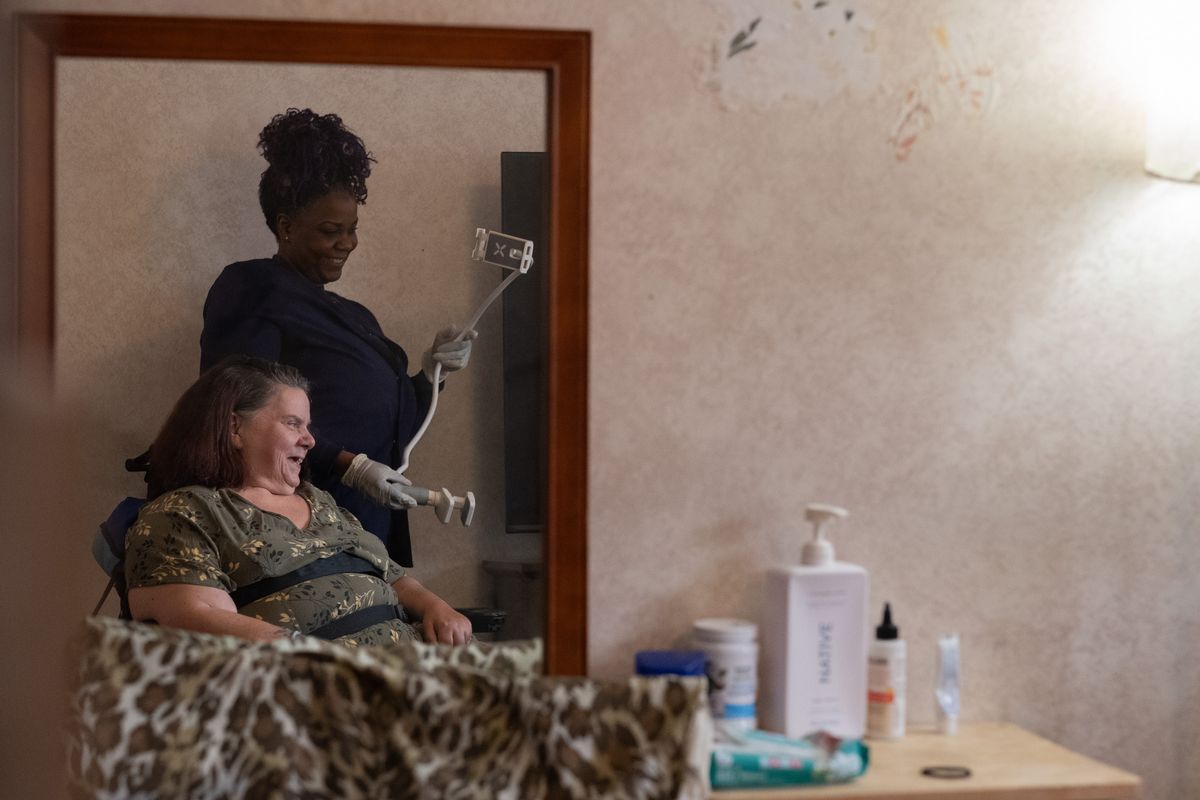
Kucera is among many disabled Americans who rely on Medicaid for legally mandated services to remain integrated in society.
14:15 JST, March 12, 2025
Jennifer Kucera has a form of muscular dystrophy that limits her ability to move. Daily caregivers help her get out of bed, bathe and dress. Without them, Kucera, 55, said she would be forced to live in an institution.
She is one of millions of disabled Americans who rely on Medicaid for legally mandated services to remain integrated in society. An ongoing lawsuit challenges these legal mandates, leaving Kucera and others fearful that their services could be cut.
“I’m basically fighting for my life,” said Kucera of Berea, Ohio, who is also an advocate for the disabled community. “It’s frightening because this lawsuit could affect everything.”
Texas v. Becerra was filed last year by Texas Attorney General Ken Paxton (R) in response to updated regulations in Section 504 of the Rehabilitation Act of 1973, a landmark federal law prohibiting disability discrimination.
Section 504 specifically prohibits any entity receiving federal funds from discriminating against people with disabilities. The updated regulations focus mainly on ensuring equal access to medical treatments and websites, providing accessible communications, and integrating disabled people into society to the fullest extent possible. The preamble to the regulations includes an acknowledgment and agreement that gender dysphoria may, in some cases, be considered a disability under Section 504, based on a 2022 ruling from the U.S. Court of Appeals for the 4th Circuit that reached the same conclusion.
The lawsuit asks the court to prevent the new regulations from being enforced and to “Declare Section 504, 29 U.S.C. § 794, unconstitutional.”
Many of the 17 attorneys general on the lawsuit have said they want to prevent the inclusion of gender dysphoria in the definition of disability and not to overturn Section 504 entirely.
“Despite the considerable misinformation about this lawsuit, the intent of this lawsuit was never to ask the Court to declare all of Section 504 unconstitutional or to in any way reduce funding for disabled children and their families,” South Dakota Attorney General Marty Jackley (R) wrote in an emailed statement.
However, many disability advocates and legal experts said the lawsuit’s text, as well as a subsequent joint report filed in late February, explicitly targets Section 504 and puts disabled people’s legal protections at risk.
“They’re using these mealymouthed, tricky phrasings to try and confuse people and mislead people to think that this is a narrow challenge, and it absolutely is not,” said Claudia Center, legal director for the Disability Rights Education & Defense Fund, a nonprofit law and policy organization focused on disability rights.
Stated intent of lawsuit does not quell concerns
Center and other legal experts pointed out language from the lawsuit characterizing the Rehabilitation Act as “coercive spending legislation” that forces states to choose between complying and losing federal funding.
Additionally, the joint filing states that the lawsuit’s intent is to challenge “any purported application of [the law] to funds that are not authorized by the Rehabilitation Act.”
This challenges nearly every area where the law is applied, such as schools, hospitals and public transportation, said Alison Barkoff, a disability law expert and professor at George Washington University’s Milken Institute School of Public Health, who worked with the U.S. Department of Health and Human Services office for civil rights on the updated 504 regulations.
Funding authorized by the Rehabilitation Act itself is very narrow, she said, and primarily supports state vocational rehabilitation programs and some employment programs.
“They did not change anything about the complaint. They did not drop the unconstitutional claim. They doubled down,” she explained. “This would be a complete change from how Section 504 has been applied for 50 years.”
When asked about the language in the lawsuit seeking to declare Section 504 unconstitutional, Louisiana Attorney General Liz Murril (R) wrote in an emailed statement that she did not support continuing with “that particular part of the lawsuit” and believes that the claim would be dropped.
Others, such as Georgia Attorney General Chris Carr (R), denied assertions that the lawsuit was targeting Section 504. In an emailed statement, he wrote that the lawsuit was only about combating “radical, progressive transgender ideology.”
Paxton did not respond to multiple requests for comment.
Disabled people fear institutionalization
Disabled people and advocates are worried that the true intent of the lawsuit is to weaken requirements on Medicaid funding to support home- and community-based services, which people like Kucera rely on to stay out of institutions.
States are required to give people Medicaid services in the most integrated setting appropriate, to satisfy Section 504’s nondiscrimination mandate. This requirement is based on a 1999 Supreme Court decision, called the Olmstead decision, which ruled that unnecessarily segregating people with disabilities into institutions was a form of discrimination. Subsequent courts affirmed the decision and ruled that putting people at risk of institutionalization was also discrimination.
However, the lawsuit challenges these requirements based on a U.S. Court of Appeals for the 5th Circuit decision that rejected the idea that a risk for institutionalization was discrimination, marking a split from most circuit court rulings on the issue, said Nicole Huberfeld, a health law professor at Boston University School of Law. The lawsuit characterizes integration requirements as “regulatory burdens” that “impose substantial costs” to states. Before the enactment of Section 504, hundreds of thousands of people with disabilities were institutionalized and not given opportunities to go to school or work. One was Veronica Ayala, 54, of Galveston, Texas, who was placed in an institution when she was 2 years old.
Ayala has cerebral palsy, which causes motor difficulty and muscle weakness. To get treatments from the state, Ayala was institutionalized.
“Most little kids are tucked into bed every night by their parents. I wasn’t,” she remembered. “It kind of severed something as far as bonding with my mother.”
Ayala lived for a few years in a state-run institution. Section 504 later allowed Ayala’s family to get her Medicaid-funded physical therapy at home, she said.
If implementation of Medicaid services is left up to the states, Ayala fears that states will choose to institutionalize more people. “If you don’t say they have to do something, they won’t,” said Ayala, now a disability rights advocate. “Even with the mandate now, they don’t do a good job.”
In many states, disabled people face long wait-lists to receive home- and community-based Medicaid services, and some still end up in institutions, where they can experience poor quality of care, neglect and isolation.
Beverley LaVia, 70, said she was “appalled” at her 39-year old son’s treatment in an institution. After a brain injury in 2016, he is blind and a quadriplegic, and he struggles to speak. He lived in an institution for one year while LaVia and her husband applied for the Medicaid services and accommodations he needed to come home. At times, her son was left in soiled diapers for hours, she said.
The family eventually got Medicaid funding to install equipment such as an in-home lift and hire personal care aides, who help her son with dressing, eating and bathing.
“Without that type of help, I don’t think we could do this, as much as we would want to, because we both also have our own medical issues,” said LaVia, of Harrisburg, Pennsylvania.
Shira Wakschlag, senior director of legal advocacy and general counsel for the Arc, a national disability advocacy organization, rejected the idea that these services were too costly or burdensome and cited data showing that community-based services are cheaper than institutionalization.
Wakschlag sees the lawsuit as part of a larger attack on Medicaid services, especially as Republicans weigh potential cuts to the program to meet goals of slashing up to $880 billion from the federal budget over 10 years.
If there are cuts to Medicaid and the states prevail with their lawsuit, Wakschlag fears that states will stop providing some disability services altogether.
Law professor Huberfeld and other experts believe that a ruling in the states’ favor could set a precedent with the potential to affect other civil rights laws such as Title VI, which bars racial discrimination, and Title IX, which bars sex-based discrimination, because they operate similarly to Section 504.
The lawsuit, Huberfeld said, is “about fighting the history of using federal funding to protect civil rights. I think states would say they want the money without the rules. But there’s a long history of states using federal funding for the wrong purposes, so they need to put conditions on the funding.”
Currently, the lawsuit is on pause. The parties to the lawsuit have been ordered to file another joint status report no later than April 21.
Kucera remembers struggling with limited access before Section 504 was implemented, including being carried into places such as the doctor’s office by her parents. She fears losing the life she has built – living in her own apartment and having a job – if the lawsuit succeeds.
“Everything I’ve accomplished could be gone in an instant,” she said. “I can’t even imagine that we might have to go back to a world like that.”
"News Services" POPULAR ARTICLE
-

American Playwright Jeremy O. Harris Arrested in Japan on Alleged Drug Smuggling
-

Taiwan President Shows Support for Japan in China Dispute with Sushi Lunch
-

Japan’s Nikkei Stock Average as JGB Yields, Yen Rise on Rate-Hike Bets
-

Japan’s Nikkei Stock Average Licks Wounds after Selloff Sparked by BOJ Hike Bets (UPDATE 1)
-

Japanese Bond Yields Zoom, Stocks Slide as Rate Hike Looms
JN ACCESS RANKING
-

Japan’s Hopes for Seafood Exports Shot Down in China Spat
-

Keidanren Chairman Yoshinobu Tsutsui Visits Kashiwazaki-Kariwa Nuclear Power Plant; Inspects New Emergency Safety System
-

Japan to Charge Foreigners More for Residence Permits, Looking to Align with Western Countries
-

Japan Exports Rise in October as Slump in U.S. Sales Eases
-

Govt Aims to Expand NISA Program Lineup, Abolish Age Restriction



























